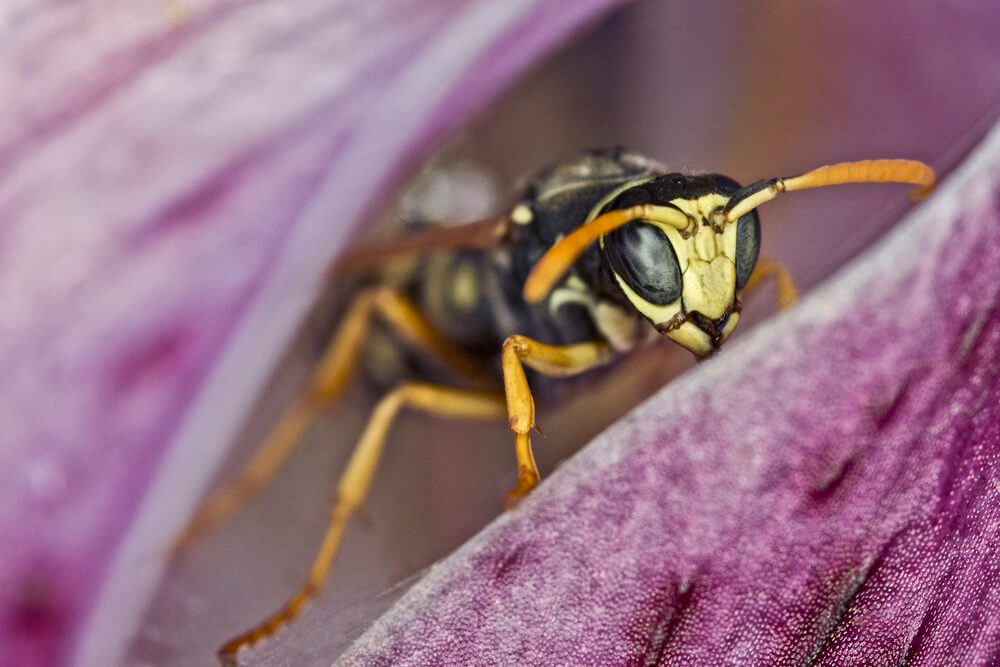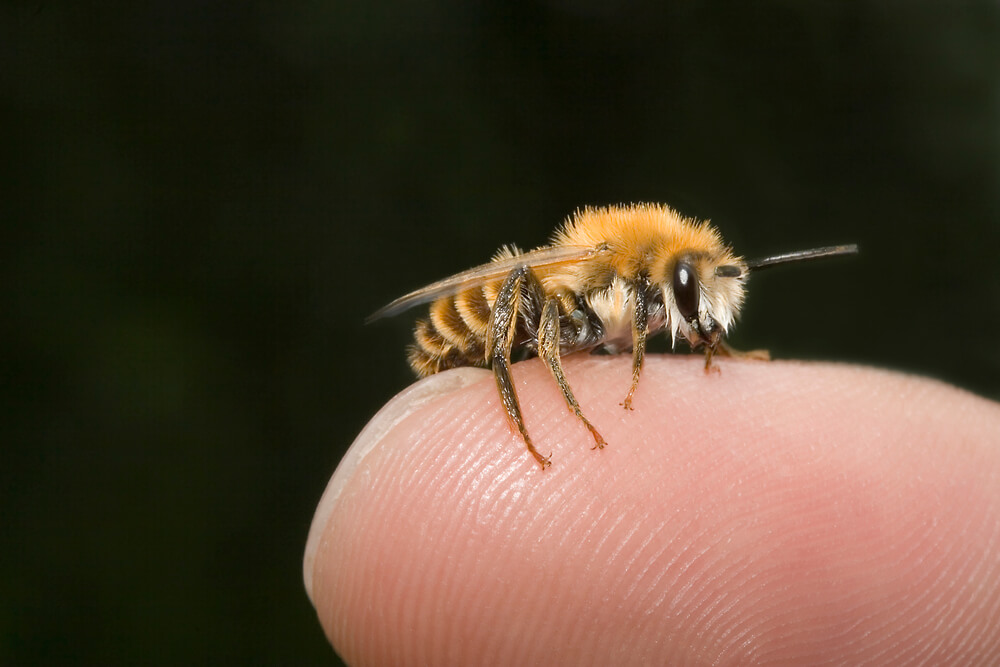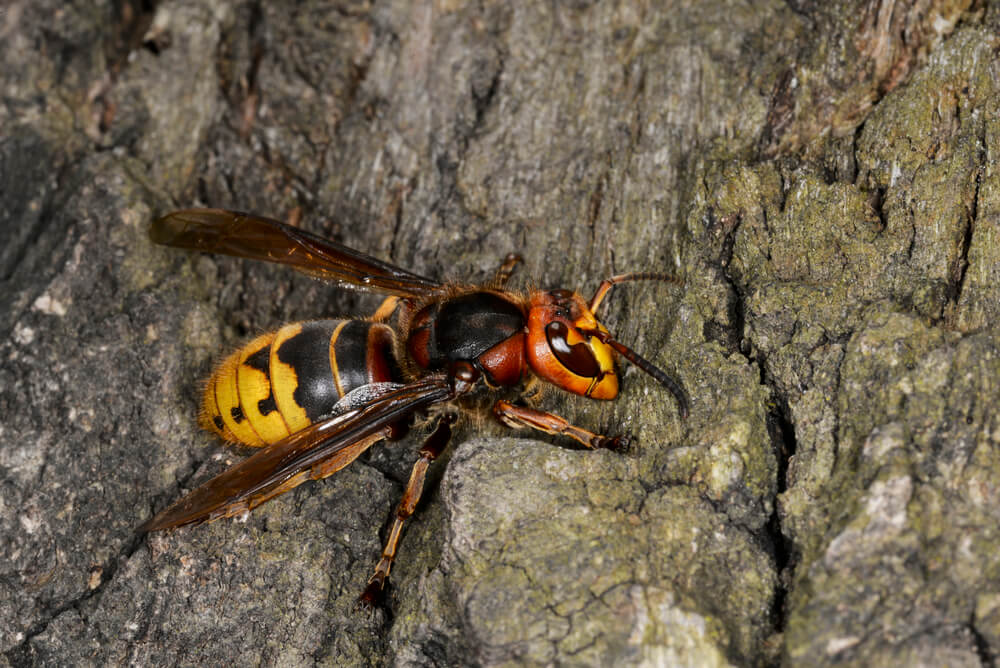Table of Contents:
Do Birds Eat Bees?
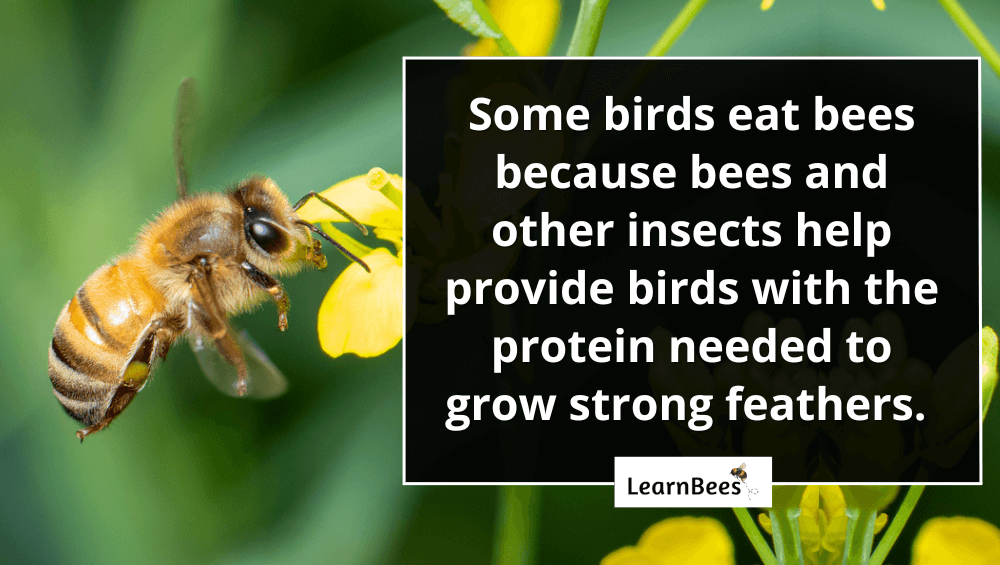
Yes, some bird species eat bees.
Most birds are omnivores that eat plants, animals, and insects. This includes eating insects such as bees, ladybugs, butterflies, dragonflies, and wasps.(1)
In fact, some birds are so well-known for eating bees that they’re named “bee-eaters.”
Examples of such birds include:
- European bee-eater
- Asian green bee-eater
- Chestnut-headed bee-eater
Now you might be thinking…
Why do birds eat bees?
Simple.
Insects like bees are a protein-rich food source for many birds. Protein is crucial for helping the bird grow strong feathers. Additionally, birds need plenty of protein to help insulate their bodies and give them the strength to fly.
And you might be surprised to learn:
A bird’s feathers are made up of over 90% protein.(2, 3)
So eating insects provides birds with the proper nutrition they need to function daily. That said, not all birds eat bees.
Here in North America, we don’t have birds that make bees their primary diet – they simply snack on them here or there. Contrastly, other parts of the world have birds that focus solely on bees for their protein source.
So let’s talk about that next.
What Birds Eat Bees?
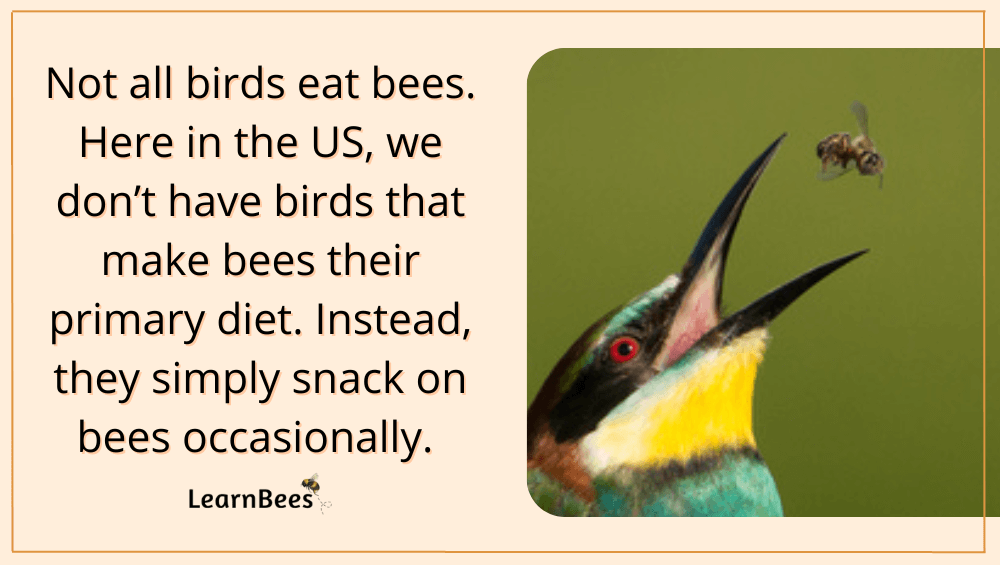
Birds eat most bees while the bees are pollinating flowers or flying near their beehive. This is because the bee is distracted and easier to catch.
Bee-eating birds will swoop down, catch the bee, and eat it. Some birds will remove the bee’s stinger during the process. Other birds simply swallow the bee whole.
Well-known examples of bee-eating birds include:
1. Summer Tanagers
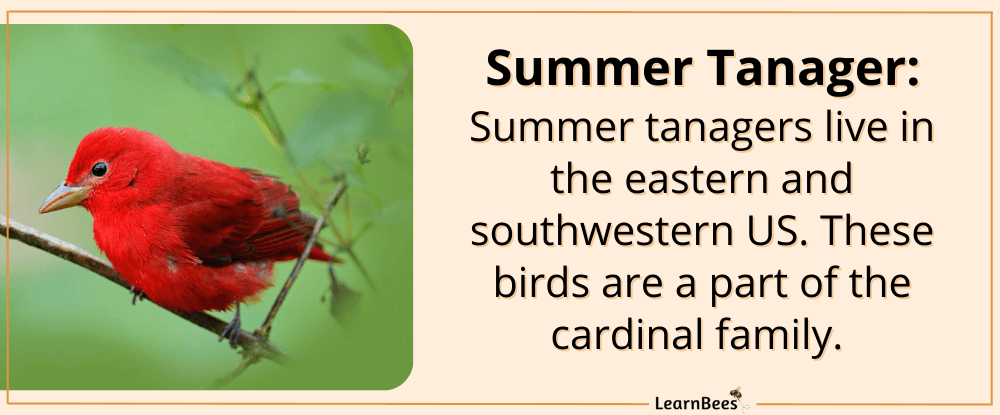
Summer tanagers (Piranga rubra) are found in much of the eastern and southwestern United States. These birds are classified as part of the cardinal family.
Summer tanagers can eat their weight in bees. They prey on bees while they’re pollinating or nesting.
In fact:
Beekeepers often have to watch summer tanagers because they’ll hang out near beehives, snacking on the bees as they enter or exit. Beehives are a honeybee buffet for these birds.
But besides eating bees, summer tanagers feast on fruit like blueberries, cranberries, and crabapples.
2. American Robins
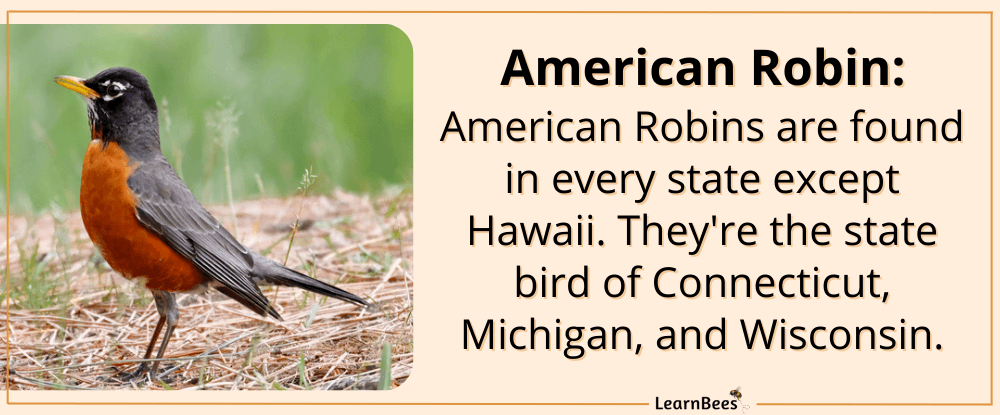
American robins (Turdus migratorius) are found in every state except Hawaii. What’s more, they’re the state bird of Connecticut, Michigan, and Wisconsin.(4)
Robins are the most active during the day; around the same time that bees pollinate flowers. Their diet consists primarily of insects like beetles, earthworms, caterpillars, and of course, bees.
But that’s not all.
Robins also eat fruit such as cherries, blueberries, and strawberries.
In turn, American robins are eaten by bobcats, foxes, hawks, owls, and shrikes. Additionally, crows and blue jays prey on robin eggs and their baby birds.
On average, American robins live for two years in the wild. But, May Thatcher Cooke, a scientist that studied birds, found that some robins live an average of six to nine years, with one wild robin living nearly 14 years.
3. Northern Mockingbirds
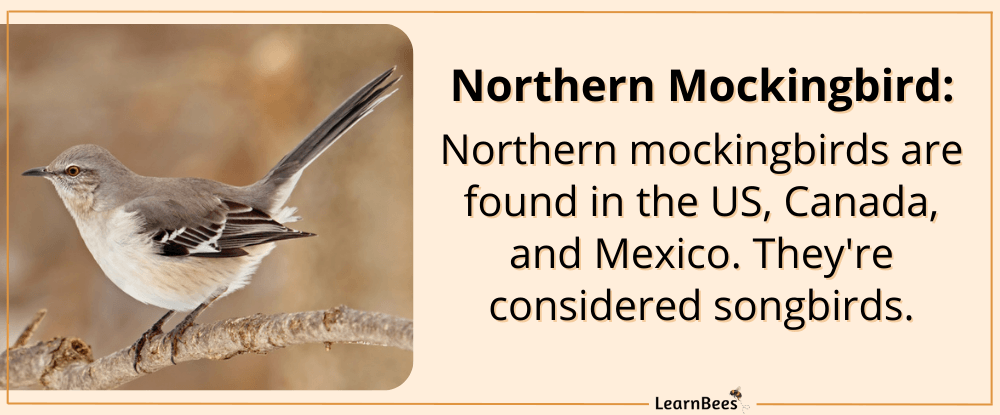
If you stand outside for any number of minutes, chances are you’ll spot a northern mockingbird (Mimus polyglottos).
These birds are found in most of the United States, Canada, and Mexico. Located in forest edges and open areas, the mockingbird is the state bird of Arkansas, Florida, Mississippi, Tennessee, and Texas.(5)
A northern mockingbird’s summer diet consists mainly of insects like moths, crickets, earthworms, and bees.
In the fall, mockingbirds switch to eating mostly fruit.
The mockingbird’s Latin name is Mimus polyglottos, which literally means “many-tongued mimic.”
Mockingbirds have earned their name due to their ability to imitate sounds from their environment. They can even sing over 100 different songs, which is why they’re considered songbirds as well.
4. Woodpeckers
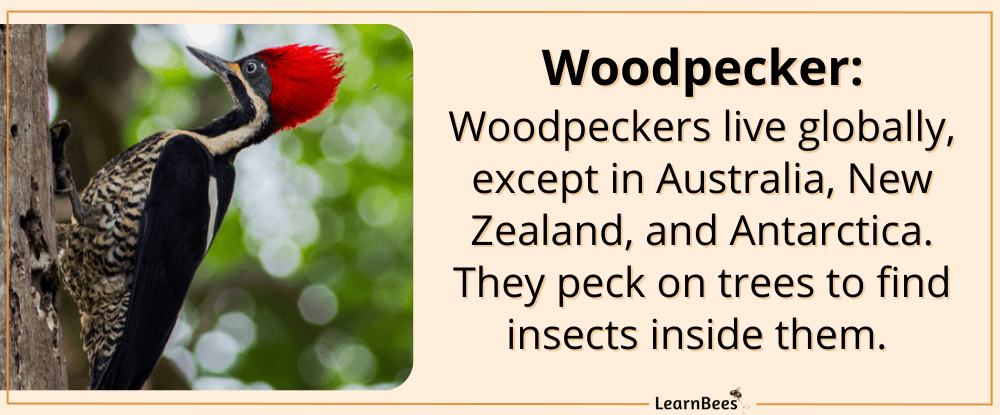
Woodpeckers (Picidae) are found worldwide, except in places like Australia, New Zealand, and Antarctica.
Woodpeckers get their name from collecting food: they peck on trees to chisel holes in them in hopes of finding insects.
This makes carpenter bees a primary target for these birds.
Carpenter bees also drill holes into trees to build their nests. The carpenter bee nests are only about one to two inches deep, allowing them to be the perfect length for woodpeckers to stick their beaks into.
Woodpeckers are prey for bobcats, foxes, coyotes, and hawks.
5. Purple Martins

Purple martins (Progne subis) are found in North, South, and Central America.
Purple martins have an insectivorous diet, meaning they eat mostly flying insects such as bees, moths, mosquitoes, and flies. They catch most of these insects while in midair.
Interestingly enough, purple martins can even drink while flying, such as when cruising over a pond or lake.
Purple martins are much faster than bees, reaching flying speeds of over 40 miles per hour. In contrast, honeybees can only reach about 20 miles per hour.
6. Bee Eaters
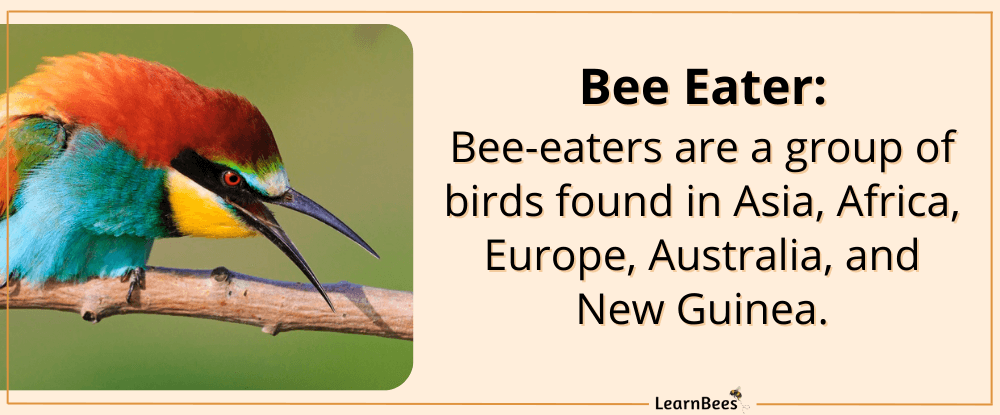
With a name like bee-eaters, you know these birds mean serious business.
Bee-eaters (Meropidae) are a group of birds found in Asia, Africa, Europe, Australia, and New Guinea. These birds are bee and wasp specialists because they get most of their protein by eating these insects.
Most bee-eaters capture bees in mid-flight, then remove the bee’s stinger by rubbing or hitting it against a hard surface like a rock. This allows the bird to eat the bee without ingesting any bee venom.
In turn, bee-eaters are preyed on by eagles or other predatory birds like falcons and hawks.
7. Honey Buzzards
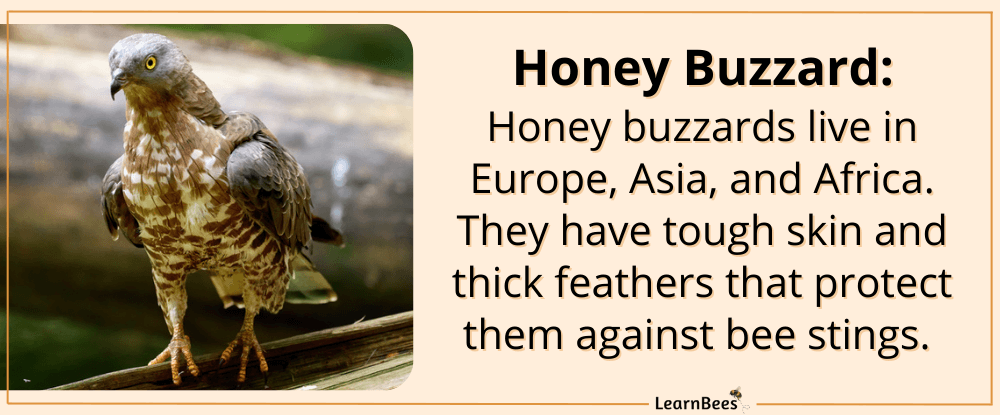
Honey buzzards (Pernis apivorus) live in Europe, Asia, and Africa.
Despite their name, a honey buzzard’s main diet doesn’t consist of honey. Instead, they primarily eat the larvae of bees and wasps.
Once honey buzzards find a bee nest, they’ll use their powerful beaks to tear into the nest and grab a chunk. From there, they’ll tote off a piece of the comb so they can eat the larvae.
And here’s the thing:
Honey buzzards have armor-like scales and feathers that protect them against bee stings. This is why it’s not unusual to see honey buzzards standing their ground near beehives. They can simply stay there and peck off the bee larvae without worrying about painful stings.
How Do Birds Eat Bees Without Getting Stung?
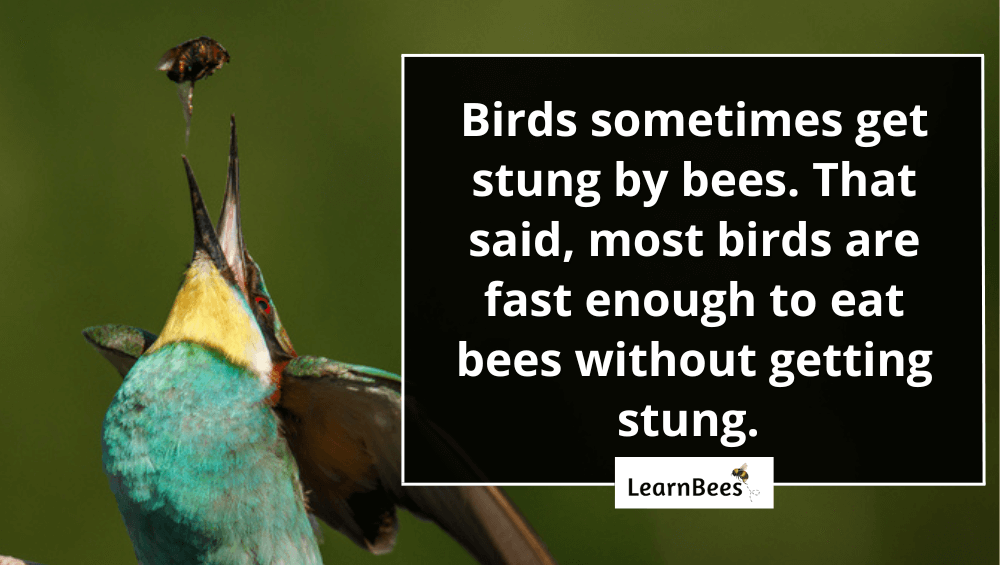
Birds do get stung by bees. However, birds are usually quick enough to capture bees and fly away without getting harmed.
That said, birds may die if they get attacked by a protective bee colony. Multiple bee stings to a bird’s small body can inject a fatal amount of venom into the bird.
For example, Africanized honeybees are a type of bee that is very protective over their nests. They’ve been known to chase animals over 1,000 feet away from their hive.
Moreover, Africanized honeybees group together in large numbers, making their attacks potentially more fatal.
As a result?
Birds are better off eating bees when they’re away from their hive. Bees are easier targets when pollinating flowers or collecting water because they’re away from their nests and don’t have the backup of their colony.
Additionally, solitary bees living alone are easier targets than bees living in colonies. Solitary bees include carpenter and mason bees, while social bees include bumblebees and honeybees.
FAQs on “Do Birds Eat Bees?”
- What is the main predator of bees?
- How do you protect bees from birds?
- What bird kills bees?
- Why do birds eat bees?
- Are bees afraid of birds?
- Do bees hurt birds?
- Do birds eat wood bees?
- Do hummingbirds eat bees?
- Do cardinals eat bees?
- Do birds eat bumblebees?
- Is there a bird called a bee-eater?
- Can a bird survive a bee sting?
- Why do bees hang around bird feeders?
- Do birds help bees?
What is the main predator of bees?
There are many predators of bees, including birds, reptiles, amphibians, mammals, and insects. The main predator of bees depends on the geographical location and the type of bee.
In North America, for example, the primary predators of bees are skunks, bears, and hive beetles. In South America, the main predators of bees are wasps and hornets. In Europe, the main predators of bees are birds, such as bee-eaters.
—> Go back to the FAQs on “Do Birds Eat Bees?”
More to Explore:
How do you protect bees from birds?
There are a few tricks for protecting bees from birds, including:
- Placing chicken wire over solitary bee houses
- Placing beehives in protected areas surrounded by bushes or plants, so they aren’t as exposed
- Using bird feeders to deter the birds away from the bees and thus bringing their attention to the feeders
If the birds are killing the bees in the air or while they’re on flowers, there isn’t much you can do. This is a part of the circle of life.
—> Go back to the FAQs on “Do Birds Eat Bees?”
More to Explore:
What bird kills bees?
People often ask:
Will birds eat bees and wasps? Do birds eat beehives?
The answer is yes; many types of birds eat bees and wasps. Common examples include bee-eaters, woodpeckers, summer tanagers, and honey buzzards.
—> Go back to the FAQs on “Do Birds Eat Bees?”
More to Explore:
Why do birds eat bees?
There are a few reasons why birds eat bees:
- Bees are an important food source for many birds, especially during summer.
- Bees are high in protein and fat, which helps birds to stay healthy and provides them with energy.
- Bees can make an easy meal for a hungry bird
—> Go back to the FAQs on “Do Birds Eat Bees?”
More to Explore:
Are bees afraid of birds?
It’s hard to say if bees are afraid of birds because we don’t understand how bees perceive fear. However, bees protect their nests and try to defend themselves if they feel threatened. This reaction is likely out of instinct rather than fear.
—> Go back to the FAQs on “Do Birds Eat Bees?”
More to Explore:
Do bees hurt birds?
In most cases, no. Bees will leave birds alone as long as they aren’t threatening them. However, if a bird does threaten a bee’s nest, the bees will swarm and attack the bird. This reaction is out of defense rather than aggression.
Multiple bee stings to a bird’s body can inject a fatal amount of venom into the bird. That said, most birds are fast enough to eat bees without getting stung.
—> Go back to the FAQs on “Do Birds Eat Bees?”
More to Explore:
Do birds eat wood bees?
Some species of birds eat wood bees. Wood bees is a nickname for a type of solitary bee that lives in tunnels in wood. These bees are better known as carpenter bees.
A typical example of birds that eat wood bees is woodpeckers. Woodpeckers eat wood bees because they are looking for bee larvae, a common food source for these birds.
—> Go back to the FAQs on “Do Birds Eat Bees?”
More to Explore:
Do hummingbirds eat bees?
Hummingbirds don’t eat bees or wasps. Their insect diet primarily includes ants, aphids, gnats, and small spiders.
—> Go back to the FAQs on “Do Birds Eat Bees?”
More to Explore:
- Ground Bees: Are They a Threat to Your Yard?
- Wasps vs. Honeybees: Are They Different?
- Do Bumble Bees Bite?
Do cardinals eat bees?
Yes, cardinals are known to eat bees and wasps. Cardinals typically eat insects that are active during the day, such as bees, wasps, and dragonflies.
—> Go back to the FAQs on “Do Birds Eat Bees?”
More to Explore:
Do birds eat bumblebees?
Yes, many types of birds will eat bumblebees, including bee-eaters, woodpeckers, summer tanagers, and honey buzzards.
—> Go back to the FAQs on “Do Birds Eat Bees?”
More to Explore:
- Do Carpenter Bees Pollinate?
- How Long Do Bumble Bees Live?
- Honeybees vs. Bumblebees: How Do They Compare?
Is there a bird called a bee-eater?
Yes, the bee-eater is a type of bird that, as you can guess, eats bees. Bee-eaters are brightly colored birds found in Africa, Europe, and Asia. These birds use their strong beaks to capture bees and remove the stingers before eating them.
—> Go back to the FAQs on “Do Birds Eat Bees?”
More to Explore:
- Do Queen Bees Eat Honey?
- Are Worker Bees Male or Female?
- Queen Bee Versus Worker Bees – How Do They Compare?
Can a bird survive a bee sting? What would happen if a bird got stung by a bee?
Yes, birds can survive bee stings as long as they weren’t stung multiple times.
The bee sting itself isn’t what kills the bird; it’s the venom injected into the bird that can be fatal. A single bee sting usually won’t inject a lethal amount of venom into a bird.
However, if a bird is stung multiple times, the venom can build up in its system and eventually kill it. That said, most birds are fast enough to eat bees without getting stung.
—> Go back to the FAQs on “Do Birds Eat Bees?”
More to Explore:
Why do bees hang around bird feeders?
Bees sometimes hover around bird feeders to collect dust particles from the seed. These dust particles contain nutrients that can help bees survive.
—> Go back to the FAQs on “Do Birds Eat Bees?”
More to Explore:
Do birds help bees?
No, many birds are considered predators of bees because they eat them.

